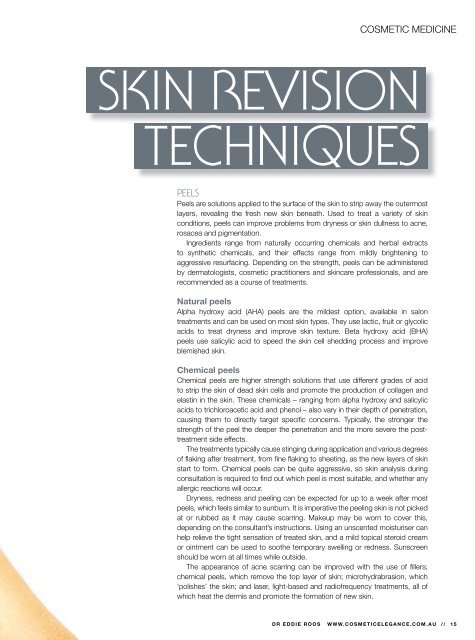Create successful ePaper yourself
Turn your PDF publications into a flip-book with our unique Google optimized e-Paper software.
COSMETIC MEDICINE<br />
SKIN REVISION<br />
TECHNIQUES<br />
PEELS<br />
Peels are solutions applied to the surface of the skin to strip away the outermost<br />
layers, revealing the fresh new skin beneath. Used to treat a variety of skin<br />
conditions, peels can improve problems from dryness or skin dullness to acne,<br />
rosacea and pigmentation.<br />
Ingredients range from naturally occurring chemicals and herbal extracts<br />
to synthetic chemicals, and their effects range from mildly brightening to<br />
aggressive resurfacing. Depending on the strength, peels can be administered<br />
<strong>by</strong> dermatologists, cosmetic practitioners and skincare professionals, and are<br />
recommended as a course of treatments.<br />
Natural peels<br />
Alpha hydroxy acid (AHA) peels are the mildest option, available in salon<br />
treatments and can be used on most skin types. They use lactic, fruit or glycolic<br />
acids to treat dryness and improve skin texture. Beta hydroxy acid (BHA)<br />
peels use salicylic acid to speed the skin cell shedding process and improve<br />
blemished skin.<br />
Chemical peels<br />
Chemical peels are higher strength solutions that use different grades of acid<br />
to strip the skin of dead skin cells and promote the production of collagen and<br />
elastin in the skin. These chemicals – ranging from alpha hydroxy and salicylic<br />
acids to trichloroacetic acid and phenol – also vary in their depth of penetration,<br />
causing them to directly target specifi c concerns. Typically, the stronger the<br />
strength of the peel the deeper the penetration and the more severe the posttreatment<br />
side effects.<br />
The treatments typically cause stinging during application and various degrees<br />
of fl aking after treatment, from fi ne fl aking to sheeting, as the new layers of skin<br />
start to form. Chemical peels can be quite aggressive, so skin analysis during<br />
consultation is required to fi nd out which peel is most suitable, and whether any<br />
allergic reactions will occur.<br />
<strong>Dr</strong>yness, redness and peeling can be expected for up to a week after most<br />
peels, which feels similar to sunburn. It is imperative the peeling skin is not picked<br />
at or rubbed as it may cause scarring. Makeup may be worn to cover this,<br />
depending on the consultant’s instructions. Using an unscented moisturiser can<br />
help relieve the tight sensation of treated skin, and a mild topical steroid cream<br />
or ointment can be used to soothe temporary swelling or redness. Sunscreen<br />
should be worn at all times while outside.<br />
The appearance of acne scarring can be improved with the use of fi llers;<br />
chemical peels, which remove the top layer of skin; microhydrabrasion, which<br />
‘polishes’ the skin; and laser, light-based and radiofrequency treatments, all of<br />
which heat the dermis and promote the formation of new skin.<br />
DR EDDIE ROOS WWW.COSMETICELEGANCE.COM.AU // 15


















